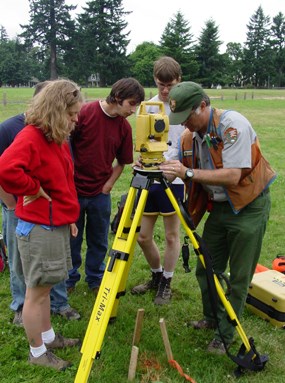
NPS Photo Overview In the summer of 2006, the National Park Service, Portland State University, and Washington State University Vancouver, held the 6th annual field school at the Vancouver National Historic Reserve. The two-part program introduced students to the methods and theories of fieldwork in historical archaeology. Students participated in all aspects of field and lab work: laying out units, excavation by shovel and trowel, mapping, drawing, photography, and cleaning, identifying, and analyzing artifacts. The season also included a lecture series featuring guest speakers and staff. Project Focus The Vancouver National Historic Reserve is an unparalleled archaeological laboratory, comprising the remains of Fort Vancouver, the ca. 1825-1860 regional headquarters and supply depot for the Hudson’s Bay Company, and Vancouver Barracks, the first (ca. 1849-2003) permanent U.S. Army post and command center in the Pacific Northwest. This year’s project continued investigations of the 1829-1860 Fort Vancouver garden.
Excavations searched for remnants of the garden well, paths and beds, and collected samples for analysis of plant remains. Knowledge gained assisted in the examination of the human-landscape interrelationship at Fort Vancouver, including the significance of the garden landscape, its layout, and the plants that grew in it. The results will support the reconstruction and interpretation of the garden area. Remnants of Army activities associated with both World Wars I and II were expected. Work also explored the U.S. Army’s Vancouver Arsenal (1856-1878) and included traditional pedestrian survey and subsurface testing techniques. The National Park Service and its partners are committed to sharing cultural resources and preservation values with the public. On a rotating basis, students discussed field school activities with visitors, interpreting the significance of the site and the educational purposes of the project. 
NPS Photo Summary of Findings In early August 2006, the 6th annual Public Archaeology Field School at the Vancouver National Historic Reserve wound up investigations of the 1829-1860 Fort Vancouver garden (Dr. McLoughlin’s garden). What was believed to be a garden well from the Hudson’s Bay Company time period which was filled with 20th century trash, was found to be a "dry" well for draining the World War I Spruce Mill. "While we had hoped to find a piece of history of the old fort, this find tells us about another very important period at the Vancouver National Historic Reserve: the World War I spruce mill," reported Dr. Douglas Wilson, National Park Service Archaeologist and director of the joint Portland State University/Washington State University Vancouver dig. The lumber mill was a military operation that cut up Sitka Spruce from throughout the Pacific coast to make into early military aircraft. The 89-year-old dry well was about 6 ft. in depth and had two simple wooden drains that emptied into it. Elsewhere, Spruce Mill deposits are over 1 ft. thick, due to the need to form a foundation for large mill buildings and to raise grades for the railroads that brought spruce "cants" to the military base. "The Spruce mill and logging operations under the Spruce Production Division was a major transitional point in the history of logging in the Pacific Northwest," said Wilson. The scope of the Mill was immense, covering all of the site of the Hudson’s Bay Company stockade and large fields to the north and east. Soldiers played a role in cutting down the spruce logs in the woods and operating the immense cut-up mill. Labor requirements for the soldiers became standard practices for logging companies and mill owners after the war. Elsewhere, researchers found remains of the old garden, including compacted surfaces that could have been garden use areas, such as paths. Typical fur-trade artifacts were found including transferprinted ceramics, clay tobacco pipe stems, and glass trade beads. In a dig near the palisade a small brass ring (less than 2 cm in diameter) of unknown function was discovered. "We know from old documents that women and children often worked in the garden," stated Heidi Pierson, National Park Service laboratory director, "It’s intriguing to hypothesize that some of these artifacts were lost by children laboring in the garden, or perhaps by one of the gentlemen or ladies who were enjoying its wide strawberry-lined paths. " The garden and orchard provided Hudson’s Bay Company employees with fresh fruit, produce, and decorative, herbal and medicinal plants; this garden also represented Britain’s easy mastery over newly acquired territories. |
Last updated: February 28, 2015
